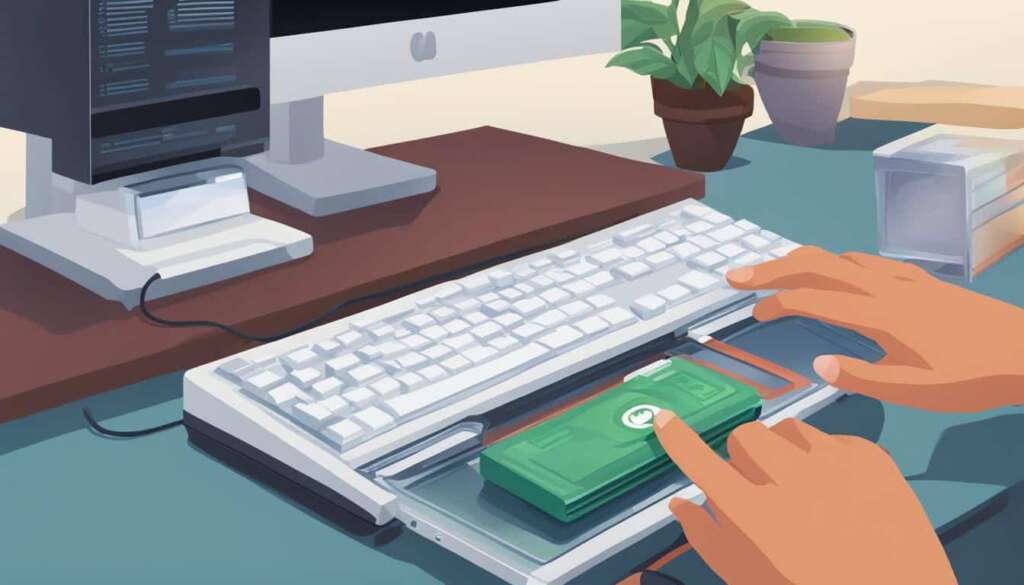Table of Contents
Backing up your PC to an external hard drive is a crucial step in securing your data and ensuring its accessibility in case of unforeseen circumstances. By creating a reliable backup system, you can safeguard your files and have peace of mind knowing that your important data is protected.
But how exactly do you backup your PC to an external hard drive? In this article, we will guide you through the process, providing easy-to-follow instructions and tips to help you secure your data effectively.
When it comes to deciding what to back up, start with personal files such as photos, videos, music, and important documents. It’s also wise to include your operating system, programs, and settings to ensure a complete backup. Remember, having multiple copies of your important files, including the original, the backup, and an additional backup, offers the best protection against data loss.
There are different methods of backing up your system, including online and local backups. While online backups provide convenience and accessibility, local backup to an external hard drive offers advantages like speed, ease of use, and secure storage.
For Windows users, the built-in Windows Backup feature, known as Restore in Windows 7 and File History in Windows 10, allows you to back up your data to an external hard drive effortlessly.
Mac users can utilize the Time Machine feature, which enables seamless backup to an external hard drive and ensures the safety of their data.
In the following sections, we will delve into the step-by-step process of setting up file history backups in Windows 10 and Time Machine backups on MacOS. By following these instructions, you’ll be able to establish a robust backup system that will protect your data and give you peace of mind.
Setting Up File History Backups in Windows 10
Backing up your files is crucial to protect your data from unforeseen events, such as hard drive failures or accidental deletions. In Windows 10, you can use the built-in File History feature to easily set up automated backups to an external SSD or hard drive. Follow these simple steps to get started:
- Connect your external SSD or hard drive to your computer.
- Make sure the capacity of your backup drive is equal to or larger than the used space on your C drive.
- Click the Windows Start button, select Settings, then go to Update & Security, and click on Backup in the left column. Alternatively, you can type “Backup” in the search field.
- Click the “+ Add a drive” button and select the connected external drive.
- Enable File History by selecting the drive you just connected.
- Set the frequency of the backup by clicking the “More options” button and choosing a suitable time interval.
- Select the duration you want to keep the backups under “Keep my backups.” You can choose a timeframe like 1 month, 6 months, 1 year, or customize it according to your preferences.
- Click “Back up now” to initiate the initial backup process. Once completed, you will see the date, time, and size of the backup listed.
With File History backups set up, your important files will be regularly backed up to the external SSD or hard drive, ensuring their safety and recoverability in case of any unforeseen data loss incidents. Now, let’s take a closer look at some of the backup settings you can customize in Windows 10:
Backup Settings
Windows 10 offers various backup settings that allow you to control how your files are backed up and stored. Here are some options you can explore:
- Backup Frequency: Choose how often File History should back up your files. You can set it to back up every hour, every day, or any other interval that suits your needs.
- Keep Backups Duration: Specify how long you want to keep your backups. Windows 10 allows you to choose the duration in months, which provides flexibility in managing storage space.
- Exclude Folders: If you have specific folders that you don’t want to include in the backup, you can exclude them from File History. This can help save storage space by avoiding unnecessary backups.
By customizing these backup settings, you can optimize your file history backups on Windows 10 to meet your specific requirements and ensure the security of your data.
Now that you’ve learned how to set up file history backups in Windows 10 and explored some of the backup settings, you’re ready to safeguard your valuable files against unexpected data loss. Invest a little time in configuring a reliable backup solution, and enjoy the peace of mind that comes with knowing your files are safely backed up.
Setting Up Time Machine Backups on MacOS
To ensure the safety and availability of your valuable data, it is essential to set up Time Machine backups on your MacOS device. Time Machine is a built-in backup feature that allows you to effortlessly back up your files and system to an external HDD or SSD.
To get started with Time Machine backups, follow these simple steps:
- Connect a macOS formatted HDD or SSD to your Mac. Make sure the drive has enough storage capacity to accommodate the backup files.
- If it’s the first time connecting the drive, a dialog box will appear, asking if you want to use the drive for Time Machine. Click “Use as a Backup Disk” to proceed.
- If you’ve already used the drive with your Mac, go to the Apple menu, select System Preferences, and click on Time Machine.
- In the Time Machine preferences window, click “Select a Backup Disk” and choose the connected external drive from the list.
- The Time Machine switch should now be set to “ON” or have “Backup Automatically” checked. This ensures that your Mac will automatically back up your data.
- You can initiate an immediate backup by selecting “Backup Now” from the Time Machine menu or simply wait for the scheduled backup to take place.
- Customize your backup preferences by clicking the Options button. Here, you can specify the backup frequency, exclude certain folders or files, and perform other advanced configurations.
For a more comprehensive and secure backup, Mac users can also create a disk image using the Disk Utility app. A disk image is a complete copy of your system, including all files, settings, and applications. This provides an additional layer of protection against data loss and allows for a seamless restoration process if needed.
By setting up Time Machine backups and creating a disk image, you can rest assured knowing that your data is protected and easily recoverable in case of any unfortunate events. Don’t leave your valuable files vulnerable, take the necessary steps to secure them today!
The Importance of External Hard Drive Backup
External hard drive backups are crucial for protecting your data. They provide contingency plans in case of hard drive failure, file corruption, or accidental file deletion. Hard drives are physical devices that can destruct, so relying on a backup stored on the same hard drive is not sufficient.
While cloud backups are convenient, external hard drive backups offer the advantage of being accessible even without an internet connection. They provide an extra layer of convenience and security.
By following good backup practices, including having a backup schedule, aiming for redundancy by using multiple external drives, backing up clean data, keeping the drive safe, and encrypting the backup if possible, you can ensure the safety and availability of your important files. Whether you’re using a Mac or a Windows PC, setting up an external hard drive backup is a smart and prudent step to protect your data.
FAQ
How do I backup my PC to an external hard drive?
To backup your PC to an external hard drive, you can follow these steps:
– Connect your external SSD or hard drive to your computer.
– Ensure that the capacity of your backup drive is equal to or larger than the used space on your C drive.
– Click the Windows Start button, select Settings, then go to Update & Security, and click on Backup in the left column. Alternatively, you can type “Backup” in the search field.
– Click the “+ Add a drive” button and select the connected external drive.
– Enable File History by selecting the drive you just connected.
– Set the frequency of the backup by clicking the “More options” button and choosing a time interval.
– Select the duration you want to keep the backups under “Keep my backups.” You can choose a time frame like 1 month, 6 months, 1 year, etc.
– Click “Back up now” to start the initial backup process. Once completed, you will see the date, time, and size of the backup listed.
How do I set up file history backups in Windows 10?
To set up file history backups in Windows 10, you can follow these steps:
– Connect your external SSD or hard drive to your computer.
– Ensure that the capacity of your backup drive is equal to or larger than the used space on your C drive.
– Click the Windows Start button, select Settings, then go to Update & Security, and click on Backup in the left column. Alternatively, you can type “Backup” in the search field.
– Click the “+ Add a drive” button and select the connected external drive.
– Enable File History by selecting the drive you just connected.
– Set the frequency of the backup by clicking the “More options” button and choosing a time interval.
– Select the duration you want to keep the backups under “Keep my backups.” You can choose a time frame like 1 month, 6 months, 1 year, etc.
– Click “Back up now” to start the initial backup process. Once completed, you will see the date, time, and size of the backup listed.
How do I set up Time Machine backups on MacOS?
To set up Time Machine backups on MacOS, you can follow these steps:
– Connect a macOS formatted HDD or SSD to your Mac.
– If it’s your first time connecting the drive, a dialog box will appear asking if you want to use the drive for Time Machine. Click “Use as a Backup Disk.”
– If you’ve already used the drive with your Mac, go to the Apple menu, select System Preferences, and click on Time Machine.
– Click “Select a Backup Disk” and choose the connected external drive from the list.
– The Time Machine switch should now be set to “ON” or have “Backup Automatically” checked.
– You can initiate an immediate backup by selecting “Backup Now” from the Time Machine menu or wait for the scheduled backup.
– Customize your backup preferences by clicking the Options button, where you can specify backup frequency, exclude folders, and more.
– Additionally, Mac users can use the Disk Utility app to create a disk image for a more comprehensive and secure backup of the entire system.
Why is external hard drive backup important?
External hard drive backups are crucial for protecting your data. They provide contingency plans in case of hard drive failure, file corruption, or accidental file deletion. Hard drives are physical devices that can destruct, so relying on a backup stored on the same hard drive is not sufficient. While cloud backups are convenient, external hard drive backups offer the advantage of being accessible even without an internet connection. They provide an extra layer of convenience and security. By following good backup practices, including having a backup schedule, aiming for redundancy by using multiple external drives, backing up clean data, keeping the drive safe, and encrypting the backup if possible, you can ensure the safety and availability of your important files. Whether you’re using a Mac or a Windows PC, setting up an external hard drive backup is a smart and prudent step to protect your data.







